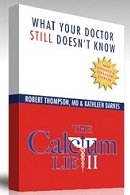Benefits of Vitamin D
Its Worth Being Sure You Get Enough
A still-growing list of illnesses shows the many benefits of Vitamin D. It may help prevent fibromyalgia, osteoporosis, pain and weakness in muscles and bones, gum disease, diabetes, arthritis, multiple sclerosis, and cancers of the breast, colon, pancreas, and prostate. Beyond avoiding these diseases and a simple Vitamin D deficiency, Vitamin D benefits the body in many ways.
Vitamin D is properly classed as a hormone because it is produced in your skin - if and when you get enough sunshine - and used in other parts of the body. Most cells in the body have receptors for it. It affects how the body makes bone, muscle, and insulin, and how the immune system fights disease ... or turns on itself in an autoimmune reaction.
Vitamin D is formed by the action of sunlight, specifically the short-wave ultraviolet (UVB) rays, or from tanning machines on our skin. Note that more sun exposure is needed for those with darker skin or for people living further from the equator in order to get the benefits of Vitamin D.
Cancer Prevention. Insufficient sun exposure is related to 2 to 3 times higher death rates from prostate, breast and colon cancers and an increase in overall cancer death rates in the northern U.S. due to the lower intensity of UV rays from the sun than further south. (Studzinski GP, Moore DC. Sunlight--can it prevent as well as cause cancer? Can Res 1995;55:4014-22.)
For example, there is a 40% lower risk of pancreatic cancer among those who got at least 600 IU a day of vitamin D compared to those who got less than 150 IU a day.
Although excessive sun exposure may give rise to skin cancer, researchers as early as 1936 were aware that skin cancer patients have reduced rates of other cancers. Scientists found a 40% lower risk of pancreatic cancer among 46,000 men and 75,000 women, those who got at least 600 IU a day of vitamin D compared to those who got less than 150 IU a day. (Cancer Epidemiol. Biomarkers Prev. 15: 1688, 2006.)
One researcher estimates moderate sunning would prevent 30,000 annual cancer deaths in the United States. Just avoid sunburns and excessive exposure. (Ansleigh HG. Beneficial effects of sun exposure on cancer mortality. Prev Med 1993;22:132-40.)
Research at Baylor University showed that animals with a healthy vegetarian diet had skin cancer rates of 0% after exposure to UV light. In another group of animals on the Standard American Diet (SAD), 25% developed skin cancer. It is the combination of too much sun and a poor diet that results in skin cancer. Vitamin D has actually been shown to be a potent angiogenesis inhibitor - that is it inhibits the growth of blood vessels to supply tumor growth. (Shokravi MT, et al. Vitamin D inhibits angiogenesis in transgenic murine retinoblastoma. Inv Oph 1995;36:83-7.)
Diabetes The results of a study on roughly 300 people aged 65 or older, a third of whom had pre-diabetes showed that fasting blood sugar levels went up significantly less over 3 years if they were given Vitamin D (700 IU/day) and calcium (500 mg/day) than if they got a placebo. "Research suggests that Vitamin D promotes insulin secretion from the beta islet cells in the pancreas, and it might influence insulin resistance." (66th Scientific Sessions of the American Diabetes Association 2006, Abstract 327-OR.)
Type 1 diabetes occurs when the immune system attacks the insulin-producing cells in the pancreas. Vitamin D reduced the incidence of Type 1 diabetes in mice predisposed to get the disease. Children recently diagnosed had reduced blood levels of Vitamin D. (Horm. Metab. Res, 37: 680, 2005)
Researchers in Finland are giving high-risk infants 2,000 IU/day to see if it can prevent Type 1 diabetes. (66th Scientific Sessions of the American Diabetes Association 2006, Abstract 1790-P.)
Multiple sclerosis Researchers found a 40% lower risk of MS in women who took at least 400 IU of Vitamin D/day. (Neurology 62: 60, 2004.)
Rheumatoid arthritis sufferers often have low Vitamin D levels. That may hinder macrophages from producing the active form of Vitamin D, which moderates an overactive immune system. (www.clinicaltrials.gov/ct/show/NCT00279461)
Bone Health One of the best-known benefits of Vitamin D is its role in promoting bone strength by increasing calcium absorption. Combined with calcium in supplement form it has been shown to reduce hip fracture risk among elderly women. In one 18-month study of 3,270 healthy women, mean age 84, the half receiving 1.2 g calcium and 800 IU of Vitamin D3 experienced 43% fewer hip fractures, 32% fewer non-vertebral fractures, and increased bone density relative to the placebo group (who lost bone density). (Chapuy MC, Arlot ME. Vitamin D3 and calcium to prevent hip fractures in elderly women. New Eng J Med 1992;327:1637-42.)
How Much Vitamin D? How much do we need to get the benefits of Vitamin D? Sun exposure on a sunny summer day can produce approximately 10,000 IU suggesting that the Canadian recommended RDA of up to 600 IU/day for adults and the 2,000 IU/day official safety limit may be much too low. Studies have shown that 200 IU/day has no effect on bone status.
In winters in Canada or northern U.S states there is no way you can get enough Vitamin D from exposure to sunlight. Vitamin D (be sure to get the D3, cholecalciferol form) is inexpensive. Be sure you get enough and in spring and summer get out in the sunshine to build up your reserves. Just avoid excessive exposure and burns.
Most people do not get enough to get all the benefits of Vitamin D. A recent study showed that 37% of adult hospital patients were Vitamin D deficient upon admission. Two-thirds of these patients did not consume enough Vitamin D from dietary sources. Significantly, 46% of those taking daily multivitamins (most including 400 IU of Vitamin D) were also deficient, indicating that 400 IU may not be adequate. (Thomas MK, et al. Hypovitaminosis D in medical inpatients. New Eng J Med 1998;338:777-83.)
Sun exposure on a sunny summer day can produce approximately 10,000 IU of Vitamin D. This in an indication that even the 2,000 IU official safety limit, may not be sufficient to derive all the benefits of Vitamin D. The 1989 RDA of 200 IU and even the newer 600 IU Daily Reference Intake (DRI) dose for adults older than 70 is still not adequate. One researcher believes the need is 4,000 - 10,000 IU /day and that toxicity is not a concern until about 40,000 IU/day. (Vieth R. Vitamin D supplementation, 25-hydroxyvitamin D concentrations, and safety. Am J Clin Nutr 1999;69:842-56.)
Vitamin D is not common in foods. One study at the Bone Research Laboratory (Boston U. School of Medicine) found that only 29% of commercial milk samples tested were within 20% of the labeled amount. Some cartons contained no measurable Vitamin D. Many people are not getting the benefits of Vitamin D because they are depending on unreliable sources. (Holick MF, et al. The Vitamin D content of fortified milk and infant formula, New Eng J Med 1992;326:1178-81.)
So what should we do about this?
Whatever you do, do not get into a Vitamin D deficiency. Be aware that a sunscreen with an S.P.F. of 8 blocks 95 percent of the skin's ability to make vitamin D and, of course, blocks the Vitamin D benefits. An S.P.F. of 15 blocks it by 99 percent. Make sure you spend some time in the sunshine, taking the necessary precautions, so that you do get adequate Vitamin D. If you are concerned about bone health consider AIM CalciAIM as a good source of calcium along with the nutrients needed for optimal absorption. In any case, either get plenty of safe sun exposure while on a good diet or be taking a supplemental form to make sure you are getting the many benefits of Vitamin D.
Here is a list of some
Vitamin D food sources
and information about a new,
entirely-vegan source of Vitamin D.
To learn more about the benefits of Vitamin D, watch this video:
|
Keep up to date with
valuable insights into
pain management via
a healthy lifestyle.
Receive the monthly
Natural Pain Relief
Guide Newsletter.
News articles, health
tips, specials, freebies.
Enter your email and name
in the form to the right.
|
|
|








New! Comments
Have your say about what you just read! Leave me a comment in the box below.